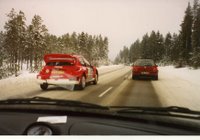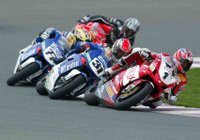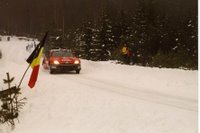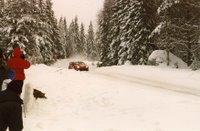In the third part of the account of my trip to the 2003 Swedish Rally, it's Saturday, Leg 2, and still bloody freezing...
Being 5am, it was still dark when my father and I woke for day two of the Swedish Rally, and we really only had one thing on our minds: breakfast. On the short walk back to the car from the pizza restaurant the previous evening, we'd passed a small cafe that promised a "smorgasbord" breakfast. This seemed like just the thing to fill the stomachs of a pair of rally spectators and boy were we right: juice, cold meats, bread, cereal, coffee, oatmeal, toast, pastries, even pickled fish (a Swedish staple). We crammed our faces with as much food as we could manage. It was something like the feeding frenzies in March of the Penguins, using the heating effect of metabolism as a defence against the arrid cold conditions. To make the scene even more quaint, the owner of the cafe was a wizened old man whose sole purpose in life seemed to be making sure that every customer left significantly heavier than he arrived. In our case, he succeeded.
The drive out to SS8, Fredriksberg, was a good 45 minutes. It was main road for the most part, until we turned hard right onto a smaller country road that ran alongside one of the long finger lakes that dot the area. At the end of this road a left turn across a bridge brought us past the entrance to the stage itself, and the top competitors were already lined up outside the FIA control zone. Our aim was to take the next access road, where we quickly found a line of cars parked. We figured we should park too, unsure of the distance to the stage. The twenty minutes we had in hand soon evaporated as the walk turned out to be at least 2km. Eventually we reached the stage, and followed the path alongside until we got to a break in the trees. As is common in many industrialized nations, when a major powerline cuts through a forest, a wide swath of trees are cut underneath, and where this particular line crossed the stage we were afforded a terrific view of three crests on a very fast straight stretch of road. We took a moment to note how warm we were in our multiple layers after the very brisk walk from the car, as well as reflect on how incredibly dry the climate was. Despite the snow, there's no moisture. It's too cold for anything to even come close to melting, so any dampness soon freezes to become completely bone dry. This made it remarkably easy to stay warm, more so than in a cold, wet environment like Wales where we ended up later that year.
Once again anticipation was building. This was, after all, only our second forest stage, and the sound of anti-lag crackling off in the distance through the trees is one of motorsport's greatest soundtracks. Cars took about three minutes to get from the startline to our spectator point, and each change in engine pitch made false promises of the car's arrival. Finally the understated white colours of Mikko Hirvonen's 15th-placed Ford Focus leapt out of the trees over a crest, engine momentarily bouncing off the rev limiter as the wheels left the ground. The effect was repeated milliseconds later as the Finn hit the second crest, and then again over the third crest right in front of us. A quick dab of the brakes as he returned to the trees and negotiated a tricky off-camber medium-right corner and then he was gone.
 One by one, the top fifteen came through, slowest to fastest. My father and I took turns taking pictures of each other with a rally car in the shot. To the right is me and my co-star, Harri Rovanpera. After the Hyundai of Freddy Loix came charging through we were expecting the bright blue Subaru of Petter Solberg next. As the seconds ticked down to the completion of the one-minute interval there was no sound. Perhaps he'd gone off? Perhaps someone else had gone off and the stage had been halted? Then, with a couple of antilag pops, Solberg emerged from the treeline at high speed, right on schedule. It was then that the penny dropped... the Subarus are whisper-quiet. It was very odd, and somewhat unsettling every time we saw Petter or his team-mate Tommi Makinen throughout the event.
One by one, the top fifteen came through, slowest to fastest. My father and I took turns taking pictures of each other with a rally car in the shot. To the right is me and my co-star, Harri Rovanpera. After the Hyundai of Freddy Loix came charging through we were expecting the bright blue Subaru of Petter Solberg next. As the seconds ticked down to the completion of the one-minute interval there was no sound. Perhaps he'd gone off? Perhaps someone else had gone off and the stage had been halted? Then, with a couple of antilag pops, Solberg emerged from the treeline at high speed, right on schedule. It was then that the penny dropped... the Subarus are whisper-quiet. It was very odd, and somewhat unsettling every time we saw Petter or his team-mate Tommi Makinen throughout the event.
When all was said and done, the most impressive sight of the stage remained young Mikko Hirvonen in the factory Ford Focus. His commitment over the crests was beyond that of anyone else, and he clearly was a boy on a mission.
After all the WRC-spec cars had gone through we headed back along the trail to the road. Before we got there, we noticed a significant break in the stream of slower Group N vehicles, and concluded that the stage had been stopped for some reason. It later turned out that Juuso Pykalisto had crashed in the stage and Harri Rovanpera had run into his stricken car. Go to 1:45 of this video to see the accident (all drivers escaped with only minor injuries).
As we were starting to learn, time was now of the essence. The drivers had SS9 (Lejen), a service period and SS10 (Vargasen) to complete in the time we had to get back to the car, drive to our next spectating point, hop on the complimentary bus from the car-park to the stage and find a place to stand. Luckily we didn't need to get lunch, since we'd bought some sandwiches at a gas station earlier. I was starting to enjoy how spectating a rally was a form of rallying in itself, where navigation, careful driving and impeccable time-keeping were crucial.
 We now faced a problem. All three of the morning's stages were east of Hagfors, and both afternoon stages were west. This meant that EVERYONE was going in the same direction on the same main road. Shortly after we passed the entrance to SS2 (Ramman), about 10 miles east of Hagfors, traffic started to get ugly. The pressure was increasing, and our decision to cut our losses and attempt only two stages was starting to look questionable. As we crawled along, cars started overtaking us, going into the lane of opposing traffic. These were no normal cars however. Check out this picture of Marcus Gronholm going by us. One by one the top rallycars passed us. It was enough to take our minds off the ticking clock, and before long we were at the intersection that was causing the traffic problems. After that, things went much more smoothly, and soon enough we were driving down the access road for SS11, Torntorp. Passing through gently rolling farmland, we parked by the side of a lake, and followed everyone else across a bridge to a bus pickup point. A steady stream of coaches were taking spectators the mile or so down the road to the stage. It was all very calm, well-ordered and comfortable. Our destination was the village of Torntorp. Nothing more than a collection of red-painted houses in the middle of an open field, connected by a road, it was temporarily home to the typical Swedish Rally crowd. Once again Norwegian flags, fires, sausages, vodka and rally-team jackets were the norm and everyone took time to enjoy each other's company as we waited for the stage to kick-off. We got talking to an English couple who were receiving real-time results via SMS, and were able to catch up on the morning's action: by now Marcus had stretched his lead to 35 seconds, and Markko Martin, Colin McRae and Petter Solberg had moved up into 4th, 5th and 6th, with the retirement of Rovanpera.
We now faced a problem. All three of the morning's stages were east of Hagfors, and both afternoon stages were west. This meant that EVERYONE was going in the same direction on the same main road. Shortly after we passed the entrance to SS2 (Ramman), about 10 miles east of Hagfors, traffic started to get ugly. The pressure was increasing, and our decision to cut our losses and attempt only two stages was starting to look questionable. As we crawled along, cars started overtaking us, going into the lane of opposing traffic. These were no normal cars however. Check out this picture of Marcus Gronholm going by us. One by one the top rallycars passed us. It was enough to take our minds off the ticking clock, and before long we were at the intersection that was causing the traffic problems. After that, things went much more smoothly, and soon enough we were driving down the access road for SS11, Torntorp. Passing through gently rolling farmland, we parked by the side of a lake, and followed everyone else across a bridge to a bus pickup point. A steady stream of coaches were taking spectators the mile or so down the road to the stage. It was all very calm, well-ordered and comfortable. Our destination was the village of Torntorp. Nothing more than a collection of red-painted houses in the middle of an open field, connected by a road, it was temporarily home to the typical Swedish Rally crowd. Once again Norwegian flags, fires, sausages, vodka and rally-team jackets were the norm and everyone took time to enjoy each other's company as we waited for the stage to kick-off. We got talking to an English couple who were receiving real-time results via SMS, and were able to catch up on the morning's action: by now Marcus had stretched his lead to 35 seconds, and Markko Martin, Colin McRae and Petter Solberg had moved up into 4th, 5th and 6th, with the retirement of Rovanpera.
The very earliest signs of twilight were showing themselves as the first few cars came through. Some were carrying light-pods, the braver ones were not. The openness of the area allowed the cars to be in sight for longer than at any of the previous stages, which was highly enjoyable. A long fast left brought the cars out of the forest, before a few fast left-right curves past the houses, over a crest towards us and then a slower right, which took them back into the trees. My abiding image of Torntorp is of Toni Gardemeister manhandling the mighty Skoda Octavia through those corners, tail flapping around like an old Mark 2 Escort. His hard work was paying off, as he ended the day in seventh.
As darkness fell we returned to Hagfors. My dad was pretty tired but I was motivated to check out service whilst the cars were still there. Since they still had to run the Hagfors Sprint one more time, the timing would be perfect. Snow was falling by the time I got to the airport, and as I moved from one team's area to the next, the cold was starting to dull my senses. I was glad I'd gone to the trouble of seeing the top contenders in service, but was starting to get hungry, damp and cold.
Dinner was a repeat performance of the previous night's pizza and beer. It was hard to turn down such a cosy, tasty experience, and we ended up sitting with an employee of the Uddeholm steel company, sponsors of the whole rally. He was Nigerian, and told a remarkable story of how he came to be in Sweden, and what it was like to work there. After he left, and our glasses were empty, we called it a night, and turned our thoughts to getting a good night's rest. Leg three promised an even tighter schedule, three stages, and a drive back to Stockholm.











